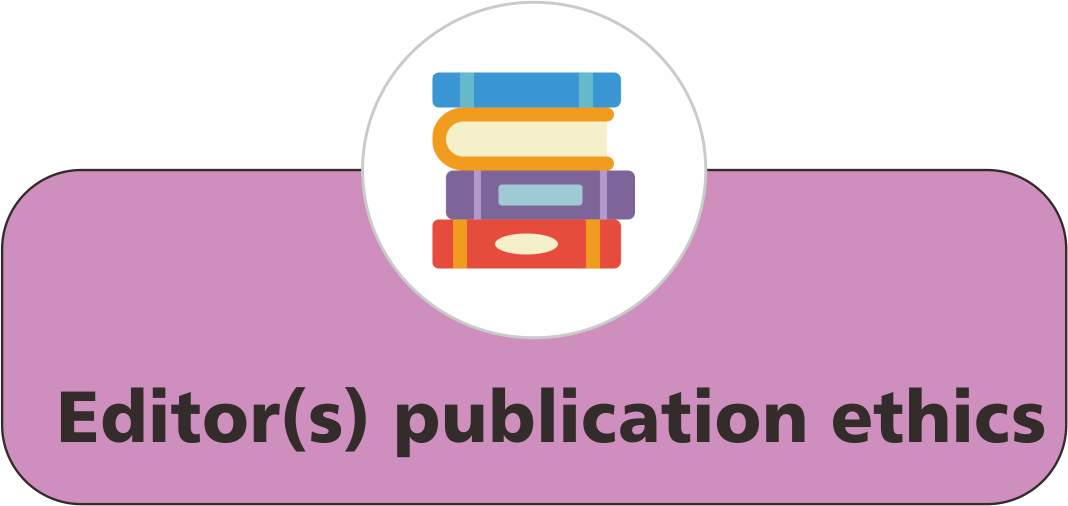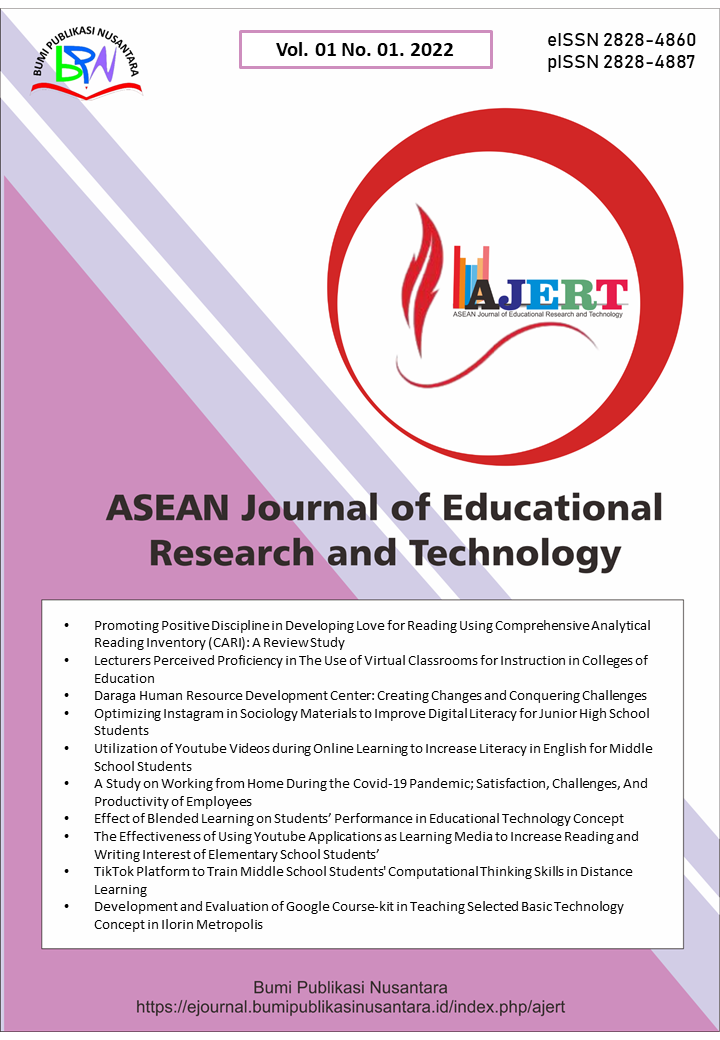Identifying Measures to Promote Teachers’ Job Satisfaction in Public Secondary School
 ),
),
(1) Al-Hikmah University Ilorin
 Corresponding Author
Corresponding Author
Abstract
Keywords
References
Amabile, T. M. (1993). Motivational synergy: Toward new conceptualizations of intrinsic and extrinsic motivation in the workplace. Human Resource Management Review, 3(3), 185-201.
Apalia, E. A. (2017). Effects of discipline management on employee performance in an organization: The case of county education office human resource department, Turkana County. International Academic Journal of Human Resource and Business Administration, 2(3), 1-18.
Atefi, N., Abdullah, K. L., Wong, L. P., and Mazlom, R. (2014). Factors influencing registered nurses perception of their overall job satisfaction: a qualitative study. International Nursing Review, 61(3), 352-360.
Aziri, B. (2011). Job satisfaction: a literature review. Management Research and Practice, 3(4), 77-86.
Bakker, A. B., and Schaufeli, W. B. (2008). Positive organizational behavior: Engaged employees in flourishing organizations. Journal of Organizational Behavior: The International Journal of Industrial, Occupational and Organizational Psychology and Behavior, 29(2), 147-154.
Barrick, M. R., Mount, M. K., and Li, N. (2013). The theory of purposeful work behavior: The role of personality, higher-order goals, and job characteristics. Academy of Management Review, 38(1), 132-153.
Bogler, R. (2001). The influence of leadership style on teacher job satisfaction. Journal of Educational Administration, 37(5), 662–683.
Crossman, A. and Harris, P. (2016). Job satisfaction of secondary school teachers. Journal of Educational Management Administration and Leadership, 34(1), 29-46.
Dartey-Baah, K., and Amoako, G. K. (2011). Application of Frederick Herzberg’s Two-Factor theory in assessing and understanding employee motivation at work: a Ghanaian Perspective. European Journal of Business and Management, 3(9), 1-8.
Du Plessis, A. J., Paine, S., and Botha, C. J. (2012). The role of human resource practitioners maintaining sustainability in organisations: Some empirical evidence of expectations, challenges and trends. International Journal of Contemporary Business Studies, 3(4), 16-35.
Ellickson, M.C. and Logsdon, K. (2001). Determinants of job satisfaction of Municipal Government employees. Journal State and Local government Review, 33(3), 173-184.
Ellsworth, R., Hawley, D. and Mau, W.J. (2008). Job satisfaction and career persistence of beginning teachers. International Journal of Educational Management, 22(1), 48-61.
Erdil, E. and Yetkiner, I.H (2001). A comparative analysis of inter-industry wage differentials: industrialized versus developing countries. Applied Economics, 33(13), 1639-1648.
Finan, F., Olken, B. A., and Pande, R. (2017). The personnel economics of the developing state. Handbook of Economic Field Experiments, 2, 467-514.
Fisher, C. D. (2003). Why do lay people believe that satisfaction and performance are correlated? Possible sources of a commonsense theory. Journal of Organizational Behavior: The International Journal of Industrial, Occupational and Organizational Psychology and Behavior, 24(6), 753-777.
Foss, N.J. and Laursen, K. (2005). Performance pay, delegation and multi-tasking under uncertainty and innovativeness: An empirical investigation. Journal of Economic Behavior and Organization, 58(2), 246–276.
Gaziel, H. H. (1986). Correlates of job satisfaction: A study of the two-factor theory in an educational setting. The Journal of Psychology, 120(6), 613-626.
Griva, M., Panitsidou, D. and Chostelidou, S. (2012). The effect of job satisfaction of the talented employees on organizational commitment: A field research. Journal of Social and Behavioral Sciences, 58, 322-30.
Guariano, U., Santibanez, M., and Daley, Q. (2006). Teachers ‘salaries. Journal of Educational Management, 15(7), 354–358.
Hanushek, E. A. (2009). Teacher deselection. Creating a New Teaching Profession, 168, 172-173.
Heyman, F. (2005). Pay inequality and firm performance: evidence from matched employer–employee data. Applied Economics, 37(11), 1313-1327.
Jirjahn, U., and Kraft, K. (2007). Intra‐firm wage dispersion and firm performance–is there a uniform relationship?. Kyklos, 60(2), 231-253.
Jyoti, J. and Sharma, RD. (2009). Job satisfaction among school teachers. IIMB Management Review, 18(4), 349-363.
Kabir, M. N., and Parvin, M. M. (2011). Factors affecting employee job satisfaction of pharmaceutical sector. Australian Journal of Business and Management Research, 1(9), 113-123.
Kenny, E. J., and Briner, R. B. (2007). Ethnicity and behaviour in organizations: A review of British research. Journal of Occupational and Organizational Psychology, 80(3), 437-457.
Khan, M. I. (2012). The impact of training and motivation on the performance of employees. Business Review, 7(2), 84 – 95.
Koustelios, A. D. (2011). Personal characteristics and job satisfaction of Greek teachers. The International Journal of Educational Management, 15(7), 354–358.
Lankford, H., and Wyckoff, J. (1997). The changing structure of teacher compensation, 1970–1994. Economics of Education Review, 16(4), 371-384.
Malik, M. E., and Naeem, B. (2013). Towards understanding controversy on Herzberg theory of motivation. World Applied Sciences Journal, 24(8), 1031-1036.
Mghana, B. L. (2013). The effects of principals’ humour on teachers’ job satisfaction. Journal of Educational Studies, 32(4), 373-385.
Muogbo, U. S. (2013). The impact of employee motivation on organisational performance (a study of some selected firms in anambra state nigeria). The International Journal of Engineering and Science, 2(7), 70-80.
Nutbeam, D., and Kickbusch, I. (1998). Health promotion glossary. Health Promotion International, 13(4), 349-364.
Orebiyi, A. O., and Orebiyi, T. P. (2011). The influence of interpersonal communication on secondary school teachers' job satisfaction and commitment in Kogi State, Nigeria. Journal of Communication and Culture: International Perspective, 2(1), 109-117.
Perrachione, B. A., Rosser, V. J., and Petersen, G. J. (2008). Why do they stay? Elementary teachers' perceptions of job satisfaction and retention. Professional Educator, 32(2), 25-41.
Phelan, S. E. and Lin, Z. (2001). Computational and mathematical. Organization Theory, 7(3), 207-232.
Roodt, G., Rieger, H., and Sempane, M. E. (2002). Job satisfaction in relation to organisational culture. SA Journal of industrial Psychology, 28(2), 23-30.
Sagie, A. (1998). Employee absenteeism, organizational commitment, and job satisfaction: Another look. Journal of Vocational Behavior, 52(2), 156-171.
Shah, S., and Jalees, T. (2004). An analysis of job satisfaction level of faculty members at the University of Sindh. JISR Management and Social Sciences and Economics, 2(1), 26-30.
Tiwari, P., and Saxena, K. (2012). Human resource management practices: A comprehensive review. Pakistan Business Review, 9(2), 669-705.
Turner, H. A., and Jackson, D. A. S. (1969). On the Stability of Wage Differences and Productivity‐Based Wage Policies: An International Analysis. British Journal of Industrial Relations, 7(1), 1-18.
Winkelhaus, S., Grosse, E. H., and Glock, C. H. (2022). Job satisfaction: An explorative study on work characteristics changes of employees in Intralogistics 4.0. Journal of Business Logistics, 43(3), 343-367.
Wu, M. S. and Short, A. (2016). The impact of person-organization fit on job satisfaction and performance of the employees. Journal of Economics and Finance, 11, 122–129.
Article Metrics
Abstract View : 1118 times
: 1118 times Download : 868 times
Download : 868 times
Refbacks
- There are currently no refbacks.
Copyright (c) 2023 Bumi Publikasi Nusantara

This work is licensed under a Creative Commons Attribution-ShareAlike 4.0 International License.









